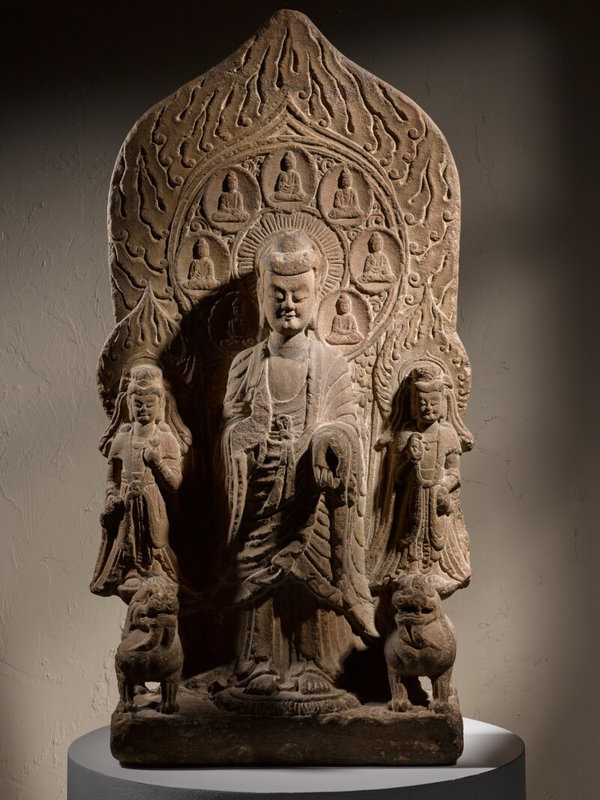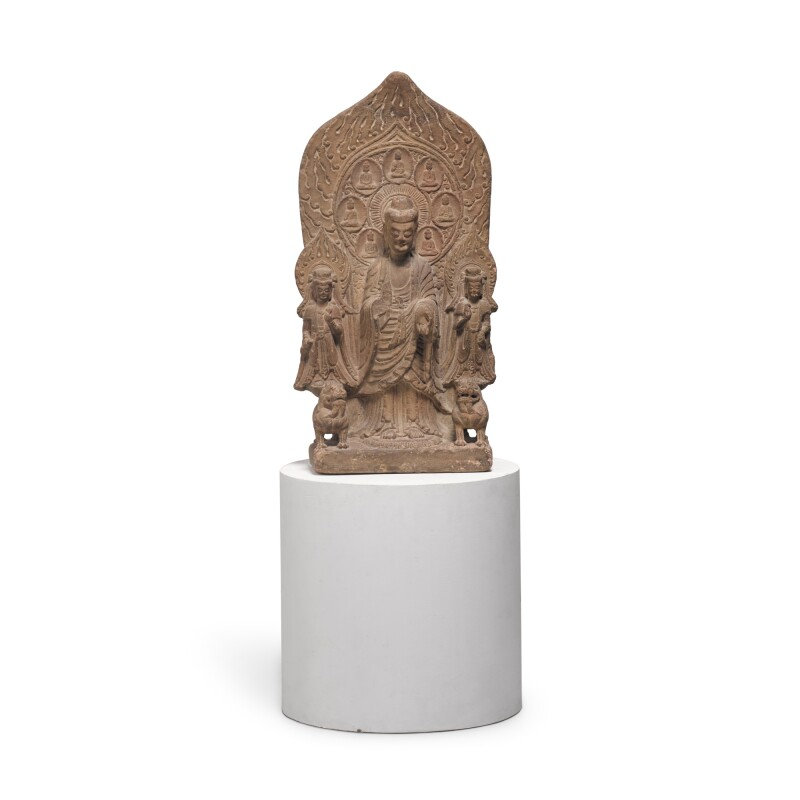A rare and important sandstone Buddhist stele, Eastern Wei dynasty (534-550)
Lot 211. A rare and important sandstone Buddhist stele, Eastern Wei dynasty (534-550). Height 36.5 cm, 14¼ in. Lot sold: £252,000 (Estimate: £200,000 - 300,000). © 2022 Sotheby's.
Property from a distinguished European Private Collection.
Provenance: Offered at Christie's London, 6th June 2000, lot 186.
Note: The graceful yet dynamic composition of this stele expresses the transcendental majesty of the Buddhist subject. The central Buddha, probably Shakyamuni, holds theleft hand in varada mudra, symbolising compassion and charity. Together with the two attendant Bodhisattvas standing above lions, the trio’s gestures convey to worshippers that they may approach and receive the blessing of the Buddha. Their faces are finely carved with downcast eyes and meditative expressions, creating a sense of serenity and tranquillity. Framing their heads are mandorla carved with flames, with seven smaller seated Buddhas further encircling the head of the main figure.
Richly carved with a vibrant scene of veneration, the present carving documents the emergence of stone steles as an important Buddhist sculptural medium in China. It evolved during the period of dynamic growth of Buddhism in the Northern Wei dynasty (386-534), when state-sponsorship of Buddhism enabled the rapid spread of the religion throughout Northern China. The 5th century saw the formation of Buddhist devotional societies throughout China. These groups sparked a burst of creativity in the production of religious art as devotees fervently commissioned steles to be made, as such acts of personal devotion were linked to the accumulation of merits for their future life. By the 6th century, these groups became the chief patrons of steles, with a smaller number sponsored by individual donors and families. A multitude of regional workshops flourished during that time, many of which developed their own style using the monumental cave temple carvings as models.
A larger (measuring 190.5 cm in height) Northern Wei stele decorated with closely related motifs is preserved in the Metropolitan Museum of Art, New York (accession no. 24.27.), illustrated in Osvald Sirén, Chinese Sculpture from the Fifth to the Fourteenth Century, vol. 2, New York, 1970, pl. 92. See also a larger (132.1 cm) stele with a related depiction of the Buddha and two Bodhisattvas, from the Eastern Wei dynasty (534-550), from the Avery Brundage Collection in the Asian Art Museum, San Francisco (accession no. B60S112+), illustrated in René-Yvon Lefebvre d’Argencé, Chinese, Korean and Japanese Sculpture in the Avery Brundage Collection, San Francisco, 1974, pl. 49.
Sotheby's. Monochrome, London, 2 November 2022

/https%3A%2F%2Fprofilepics.canalblog.com%2Fprofilepics%2F1%2F0%2F100183.jpg)
/https%3A%2F%2Fstorage.canalblog.com%2F03%2F02%2F119589%2F96711876_o.jpg)
/https%3A%2F%2Fstorage.canalblog.com%2F11%2F31%2F119589%2F94773502_o.jpg)
/https%3A%2F%2Fstorage.canalblog.com%2F20%2F83%2F119589%2F94772815_o.jpg)
/https%3A%2F%2Fstorage.canalblog.com%2F26%2F72%2F119589%2F75604929_o.jpg)
/https%3A%2F%2Fstorage.canalblog.com%2F59%2F60%2F119589%2F26458628_o.jpg)











/http%3A%2F%2Fstorage.canalblog.com%2F80%2F37%2F119589%2F129777139_o.jpg)
/http%3A%2F%2Fstorage.canalblog.com%2F59%2F28%2F119589%2F129531508_o.jpg)
/http%3A%2F%2Fstorage.canalblog.com%2F39%2F44%2F119589%2F122417439_o.jpg)
/http%3A%2F%2Fstorage.canalblog.com%2F24%2F42%2F119589%2F121295195_o.jpg)